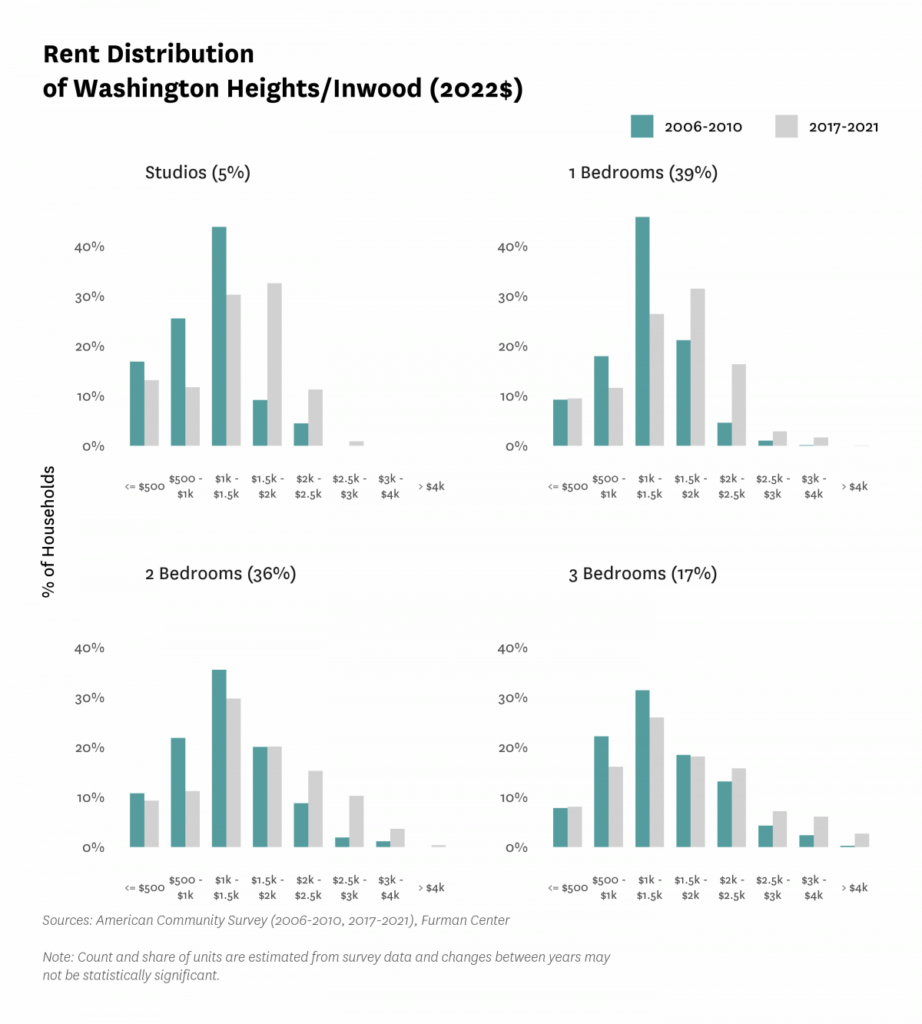No man is an island, but Manhattan is an island. At the very tippy top of that island sits a rarely mentioned little neighborhood that is still technically part of that grand legend New York City, where everyone dreams of living.
If you want to live in New York City but find the more central, better-known places to be unattainable, maybe Inwood is the place for you. The first thing you need to know is whether Inwood is a safe place to make a home or raise a family.
Where Is Inwood?
New York City is composed of five boroughs. Two of them are islands. Staten Island and Manhattan, the image which you probably most associate with New York City from shows like ‘Friends’, ‘Seinfeld’, and ‘Sex And The City’.
In fact, if you’re a cinephile, you might recognize Inwood from the Leonardo Dicaprio film ‘The Basketball Diaries’ about poet and musician Jim Carroll, who was born and raised in the area.
Inwood rests at the very northernmost tip of New York City and is bounded on three sides by a river. The Hudson River to the west and the Harlem River to the north and east, to be exact. It is bordered on the south by Fort George. Fort George is a sub-neighborhood nearby with a rich history dating back to the American Revolution.
Inwood might be best known for a type of marble that comes from the area, the eponymously named Inwood Marble. It is a soft, white, metamorphic rock that was used in the past for government buildings until the material was found to be a little unstable and, thus, unsafe.
Inwood In The Past
Inwood was supposedly sold to a Dutch settler by an indigenous tribe for sixty Dutch guilders. A plaque commemorating the spot the sale took place sits on a hill in an Inwood park.
The area has quite the colonial history, having been the site of an encampment during the American Revolution when British soldiers were occupying Manhattan, a site which was archaeologically unearthed in 1914.
Inwood is and always has been considered the most rural part of Manhattan, almost a separate entity, as described in a 1930s government report. The last family-owned farm in Manhattan is believed to have been in Inwood, finally getting sold and undergoing development in the fifties.
From the late 1800s to the early 1900s, for about thirty years, Inwood was home to an amusement and trolley park. Beyond that, Inwood has remained a quasi-suburban community insulated by hills and rivers.
Fun Facts!
Fun Fact! #1: In the nineteenth century, numbered streets weren’t popular yet, so many streets were named after American authors, including Cooper Street, which is named for James Fenimore Cooper, author of ‘The Last Of The Mohicans’.
Fun Fact! #2 Another Inwood street is honorarily named, but not for a writer. For American Civil War General Daniel Edgar Sickles. Why is he notorious? Because before the war, he shot his wife’s lover, Francis Barton Key, son of Francis Scott Key, who wrote the US national anthem, ‘The Star-Spangled Banner’.
Sickles later forgave his wife, leading to scorn from the American public.
Inwood Demographics
For a long time, Inwood was mostly Irish, but the neighborhood’s demographics have shifted to primarily Dominican.
The neighborhood displayed a predominantly Irish identity up until the 1950s, with Irish pubs, a Gaelic football field, and Irish shops dotting the area. Then those Irish and Jewish residents migrated to the outer boroughs and, up through the 1980s, were replaced by Dominicans.
Today, Inwood has the highest concentration of Dominican residents in Manhattan and almost half the residents were not born in the country.
The population of Inwood and nearby Marble Hill is around fifty thousand but has been on the decline. Over seventy percent of that population is Hispanic. Another seventeen percent is white and around seven percent is African American. The rest are Asian or of mixed race.
The average age of residents is close to forty and the average income is around sixty thousand USD annually. A quarter of residents are in the 100,000 – 250,000 per year income bracket. About 27% of residents of Inwood live below the poverty line.
The Inwood Real Estate Market
Inwood is today sometimes called ‘the last affordable neighborhood in New York City. New construction is rare, due to land use and zoning regulations. Thus, the skyline is low, because the skyscraper crazes never penetrated Inwood. Inwood is probably best recognizable for the distinctive Art Deco buildings constructed in the 1930s.
Overwhelmingly, residents rent rather than own their habitats. An undeniable ninety one percent of residents rent their home in Inwood. Ninety two percent of units are occupied in Inwood.

Rents in inwood start at about fifteen to sixteen hundred dollars per month for a studio or 2-bedroom apartment and you can actually find some three bedrooms for under three thousand.
Appropriately, home ownership is much more affordable and prices are within reach. A one-bedroom starts at just over three hundred thousand USD. For these days,a remarkably low price.
Inwood Transportation
Inwood is served by the Metropolitan Transit Authority of New York City. Buses and subways will get you where you need to go.
The average commute time for work for residents of Inwood is almost forty minutes. The most common form of travel is by car followed by public transportation. Cycling is catching up in the rear. A solid percentage of residents walk to work too.
The commute to Wall Street by public transportation is about 55 minutes. To Rockefeller Center, about 45 minutes. Getting to New Jersey will take about an hour.
Residents report that there are an amazing amount of bus and subway options, including a Metro-North suburban rail station nearby. They call the A Train route pleasant, although sometimes crowded. Residents do note that parking can be hard to score.
For cycling enthusiasts, try the thirty-one mile Manhattan Waterfront Greenway bike path. It takes you all around Manhattan, by rivers, through parks, and under bridges.
Inwood Health
Only sixty-eight percent of residents describe their health as good, very good, or excellent, which is a full ten percent below the citywide average. Also below the citywide average is the number of people who report eating fruits and vegetables every day.
The average life expectancy is eighty-four, which is above the citywide average by over two years. Air pollutant rates are a little higher too. Luckily, the area has a fairly low rate of uninsured residents.
The leading cause of death is heart disease. If you do need hospital care, there is a nearby Mount Sinai urgent care room. Inwood is also served by Gotham Health, a member of the NYC Health+Hospitals network. The New York – Presbyterian Allen Hospital is also close.
Inwood Schools
Inwood is considered a family-friendly neighborhood. About twenty-five percent of the population are families with children. About a third of households have children.
Residents say they are happy they could raise their kids in Inwood. They declare the neighborhood close-knit and special and say family and friends grow old together.
School attendance is based on a public lottery system and all the schools have a different approach. There are some very good dual-language schools in the neighborhood. The schools are overseen by District Six of the New York City Board Of Education.
There are a growing number of public charter schools and private religious schools in the area. Many schools in the area have positive attributes and glowing reviews. Some sought after specialty schools include Muscota and the High School For Excellence and Innovation.
The one drawback is that Inwood has a higher rate of dropouts than the rest of the city as a whole.
Another plus for the kids around Inwood is nature. There are a lot of parks, including the massive Inwood Hill Park. This park is home to the last standing natural forest in Manhattan and features ten miles of hiking trails, three playgrounds, and two tennis courts. Plus, a waterfront promenade and more!
Parents add that Little League is huge in Inwood! Good thing Inwood Hill has a baseball field too.
Isham Park and Tryon Park are also popular. Tryon Park showcases breathtaking views of the Hudson River.
Inwood Politics
Inwood is under the jurisdiction of Manhattan Community District 12.
Fun Fact! The primary ZIP code is 10034, but depending on how you define the southern boundaries, Inwood can be considered to fall into one or two zip code zones.
Inwood is primarily represented by Democrats. It is in the 13th Congressional District, represented nationally by Adriano Espaillat. Statewide, Inwood is represented by Democrats in the 71st and 72nd State Assemblies and the 31st State Senate District.
Locally, Inwood is under the jurisdiction of New York City Council District 10. District 10 is represented by Carmen De La Rosa, who fittingly emigrated to Inwood from the Dominican Republic as a child.
But Is Inwood Safe?
Inwood is patrolled by the 34th Precinct of the New York Police Department, which ranks 23rd safest per capita crime in New York City. There are also Neighborhood Coordination Officers that can be accessed through the precinct web page. Recent crime stats can also be found through the website.
Generally, Inwood has consistently ranked among the safest areas in New York City, with a relatively low violent crime rate. Especially safe are the parks where the community tends to gather. The police presence is also active and quick to respond..

The property crime rate is lower than both Manhattan and the all five boroughs. The one downside is that the neighborhood does have a higher incarceration rate than the rest of the city. Overall, in many categories, crime has decreased over forty percent from 1998 to 2021.
Residents say that mostly they feel completely safe and that police and community relations have improved quite a bit. However, some residents still stick to busier streets for recreational activities such as running. They note that although they still lock their doors, there are always people out and about no matter the hour, because Inwood is still New York City!
Is Inwood A Good Place To Live? What The Residents Say
The word residents use most to describe Inwood is friendly. Over seventy percent say there is a good sense of community and their top two tips for those moving into the neighborhood are to get involved in the community and get to know your neighbors.
They love all the green space and think the neighborhood is undervalued. People know each other’s neighbors on a first name basis and even their supermarket managers! Residents all agree that the neighbors are the best part of Inwood.
Overall, residents describe Inwood as a hidden gem and insist that they wouldn’t want to live anywhere else.
Conclusion
With a tight-knit community like that, it’s much easier to feel and stay safe. Although some parts of Inwood are still a little seedy, mostly Inwood is a safe and quiet corner of New York City for you to make a place for yourself.
“PLEASE NOTE: Some data and statistics may have been derived from general reports on the combined demographics of Washington Heights, Inwood, and Marble Hill.

Born and raised amidst the hustle and bustle of the Big Apple, I’ve witnessed the city’s many exciting phases. When I’m not exploring the city or penning down my thoughts, you can find me sipping on a cup of coffee at my favorite local café, playing chess or planning my next trip. For the last twelve years, I’ve been living in South Williamsburg with my partner Berenike.

